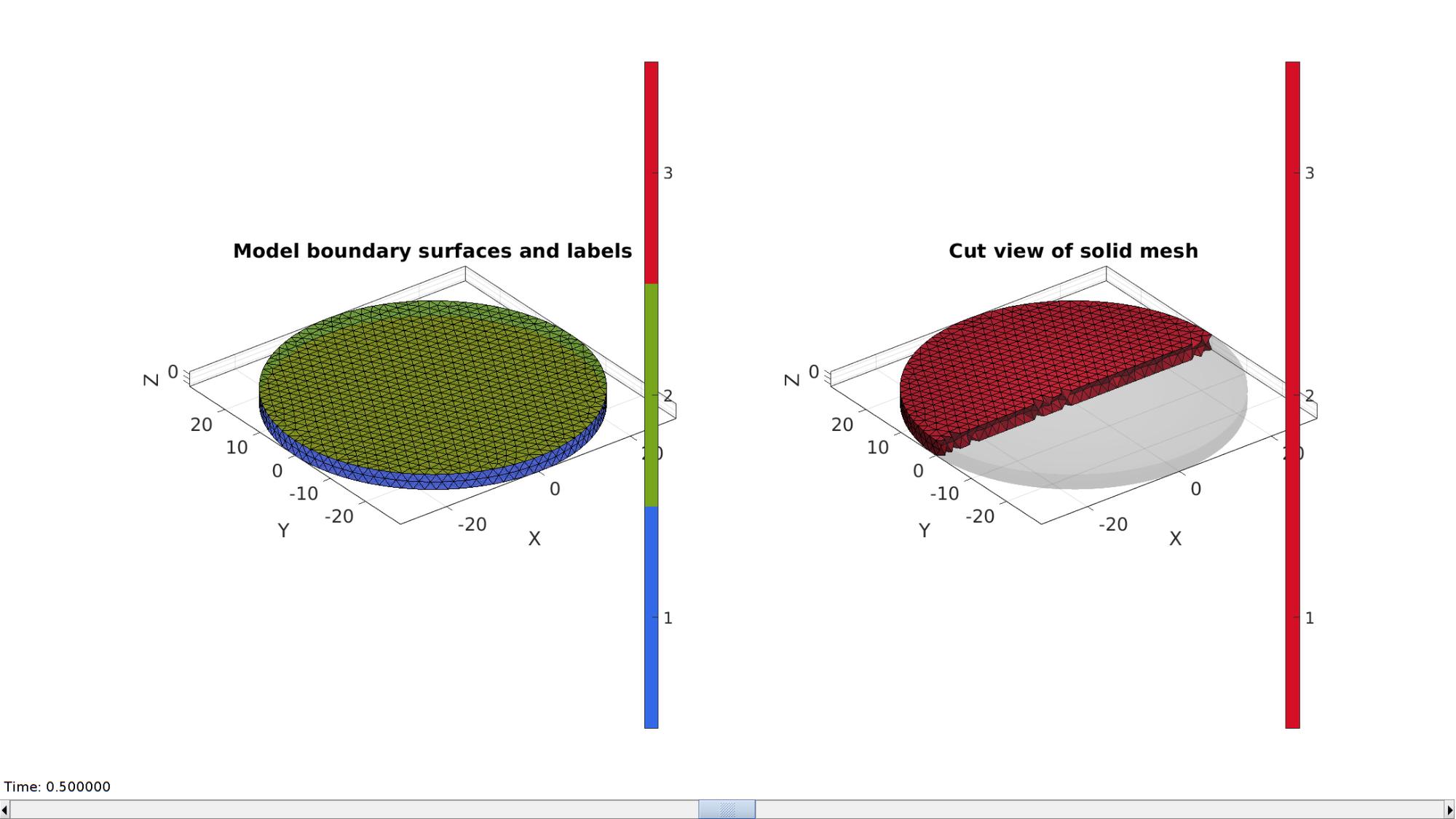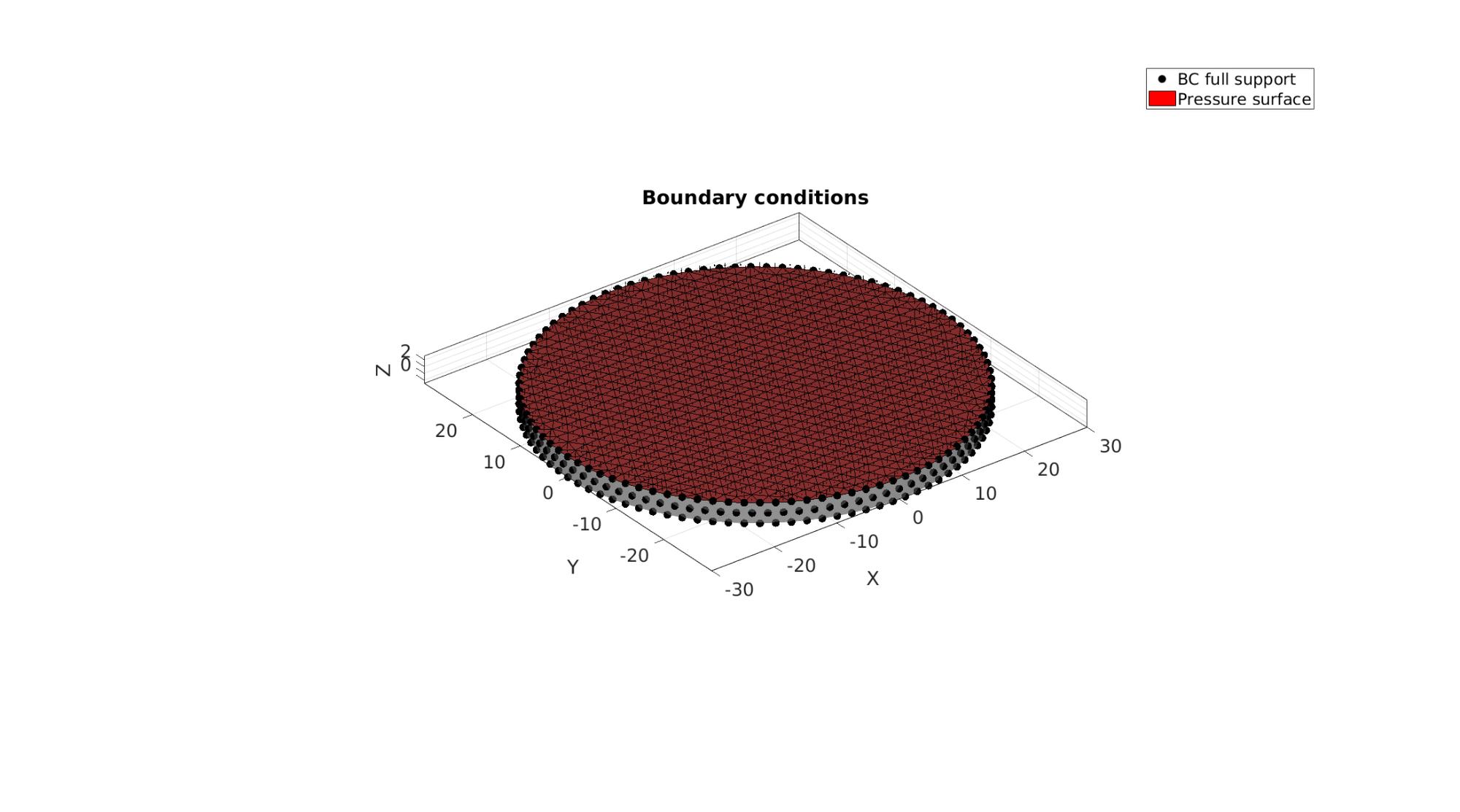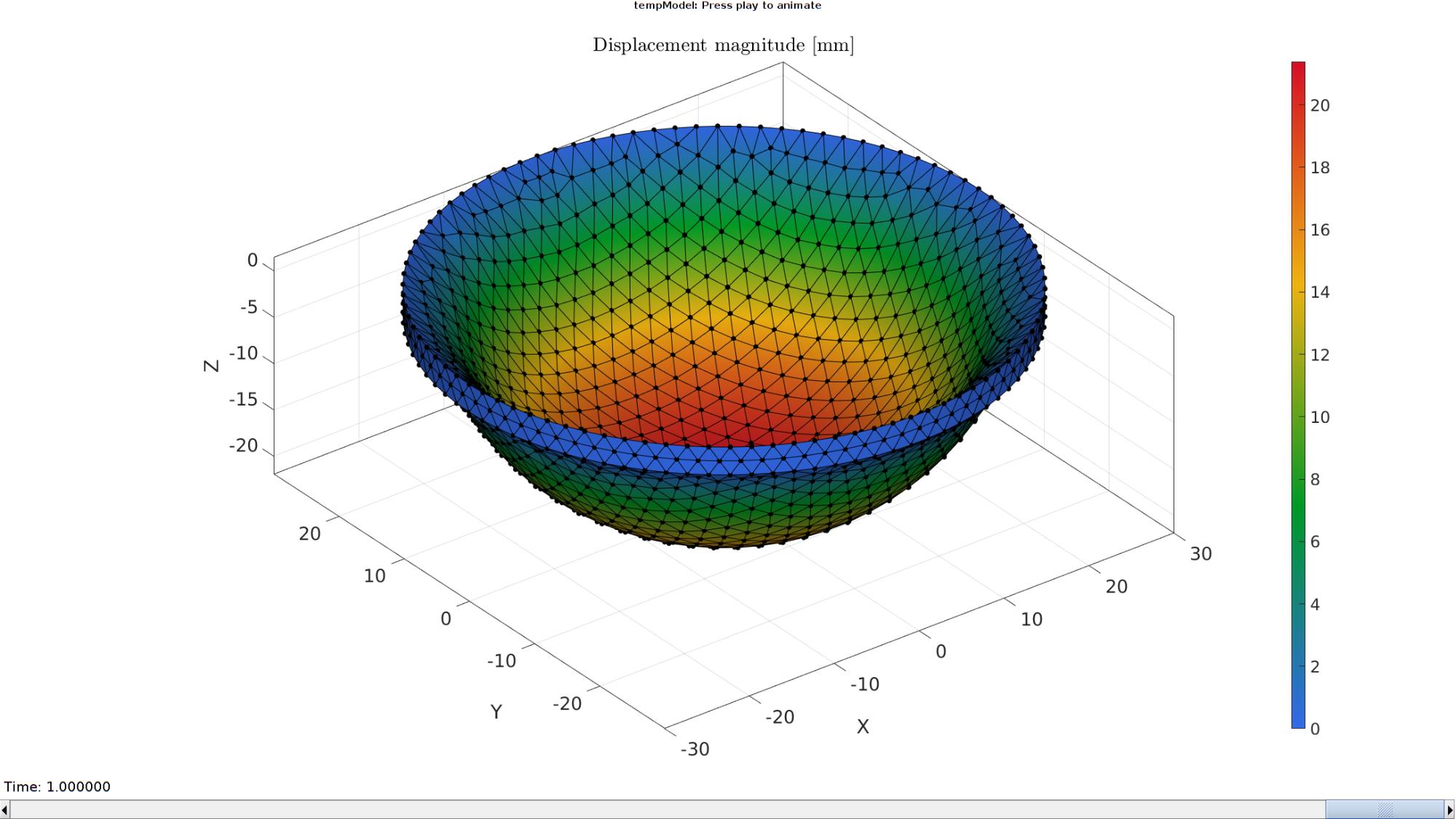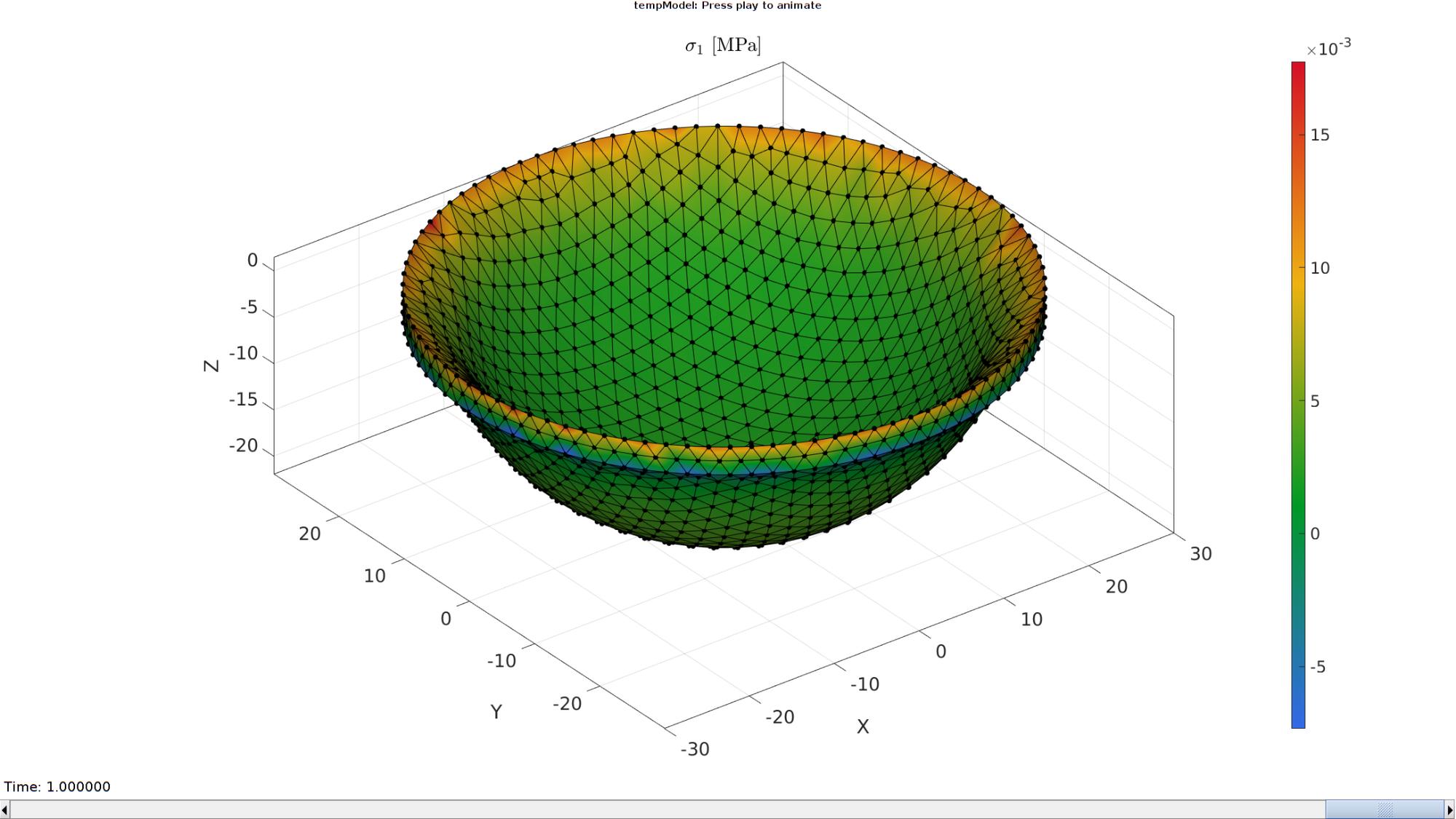DEMO_febio_0012_disc_pressure
Below is a demonstration for:
- Building geometry for a thin disc with tetrahedral elements
- Defining the boundary conditions
- Coding the febio structure
- Running the model
- Importing and visualizing the displacement and stress results
Contents
Keywords
- febio_spec version 4.0
- febio, FEBio
- pressure loading
- tetrahedral elements, hex4
- tetgen
- disc
- static, solid
- hyperelastic, Ogden
- displacement logfile
- stress logfile
clear; close all; clc;
Plot settings
fontSize=20; faceAlpha1=0.8; markerSize=30; markerSize2=20; lineWidth=3;
Control parameters
% Path names defaultFolder = fileparts(fileparts(mfilename('fullpath'))); savePath=fullfile(defaultFolder,'data','temp'); % Defining file names febioFebFileNamePart='tempModel'; febioFebFileName=fullfile(savePath,[febioFebFileNamePart,'.feb']); %FEB file name febioLogFileName=[febioFebFileNamePart,'.txt']; %FEBio log file name febioLogFileName_disp=[febioFebFileNamePart,'_disp_out.txt']; %Log file name for exporting displacement febioLogFileName_stress=[febioFebFileNamePart,'_stress_out.txt']; %Log file name for exporting stress %Load appliedPressure=0.5e-3; loadType='pressure';%'traction'; %Specifying dimensions and number of elements pointSpacing=1; inputStruct.cylRadius=30; inputStruct.numRadial=round((inputStruct.cylRadius*pi)/pointSpacing); inputStruct.cylHeight=3; inputStruct.numHeight=round(inputStruct.cylHeight/pointSpacing); inputStruct.meshType='tri'; inputStruct.closeOpt=1; % Derive patch data for a cylinder [Fs,Vs,Cs]=patchcylinder(inputStruct); %Material parameter set c1=1e-3; %Shear-modulus-like parameter m1=8; %Material parameter setting degree of non-linearity k_factor=1e2; %Bulk modulus factor k=c1*k_factor; %Bulk modulus % FEA control settings numTimeSteps=10; %Number of time steps desired max_refs=25; %Max reforms max_ups=0; %Set to zero to use full-Newton iterations opt_iter=6; %Optimum number of iterations max_retries=5; %Maximum number of retires dtmin=(1/numTimeSteps)/100; %Minimum time step size dtmax=1/numTimeSteps; %Maximum time step size runMode='external';% 'internal' or 'external'
Creating model geometry and mesh
The disc is meshed using tetrahedral elements using tetgen
inputStruct.stringOpt='-pq1.2AaY'; inputStruct.Faces=Fs; inputStruct.Nodes=Vs; inputStruct.holePoints=[]; inputStruct.faceBoundaryMarker=Cs; %Face boundary markers inputStruct.regionPoints=getInnerPoint(Fs,Vs); %region points inputStruct.regionA=tetVolMeanEst(Fs,Vs); %Volume for regular tets inputStruct.minRegionMarker=2; %Minimum region marker [meshStruct]=runTetGen(inputStruct); % Mesh model using tetrahedral elements using tetGen
%%%%%%%%%%%%%%%%%%%%%%%%%%%%%%%%%%%%%%%%%%%%% --- TETGEN Tetrahedral meshing --- 20-Apr-2023 10:40:55 %%%%%%%%%%%%%%%%%%%%%%%%%%%%%%%%%%%%%%%%%%%%% --- Writing SMESH file --- 20-Apr-2023 10:40:55 ----> Adding node field ----> Adding facet field ----> Adding holes specification ----> Adding region specification --- Done --- 20-Apr-2023 10:40:55 --- Running TetGen to mesh input boundary--- 20-Apr-2023 10:40:55 Opening /mnt/data/MATLAB/GIBBON/data/temp/temp.smesh. Delaunizing vertices... Delaunay seconds: 0.033457 Creating surface mesh ... Surface mesh seconds: 0.002375 Recovering boundaries... Boundary recovery seconds: 0.006551 Removing exterior tetrahedra ... Spreading region attributes. Exterior tets removal seconds: 0.000892 Recovering Delaunayness... Delaunay recovery seconds: 0.015868 Refining mesh... 2442 insertions, added 1067 points, 174 tetrahedra in queue. 813 insertions, added 37 points, 0 tetrahedra in queue. Refinement seconds: 0.034217 Smoothing vertices... Mesh smoothing seconds: 0.036142 Improving mesh... Mesh improvement seconds: 0.002512 Writing /mnt/data/MATLAB/GIBBON/data/temp/temp.1.node. Writing /mnt/data/MATLAB/GIBBON/data/temp/temp.1.ele. Writing /mnt/data/MATLAB/GIBBON/data/temp/temp.1.face. Writing /mnt/data/MATLAB/GIBBON/data/temp/temp.1.edge. Output seconds: 0.026898 Total running seconds: 0.159093 Statistics: Input points: 1832 Input facets: 3660 Input segments: 5490 Input holes: 0 Input regions: 1 Mesh points: 2936 Mesh tetrahedra: 11933 Mesh faces: 25696 Mesh faces on exterior boundary: 3660 Mesh faces on input facets: 3660 Mesh edges on input segments: 5490 Steiner points inside domain: 1104 --- Done --- 20-Apr-2023 10:40:56 %%%%%%%%%%%%%%%%%%%%%%%%%%%%%%%%%%%%%%%%%%%%% --- Importing TetGen files --- 20-Apr-2023 10:40:56 --- Done --- 20-Apr-2023 10:40:56
Access model element and patch data
Fb=meshStruct.facesBoundary; Cb=meshStruct.boundaryMarker; V=meshStruct.nodes; CE=meshStruct.elementMaterialID; E=meshStruct.elements;
Plotting model boundary surfaces and a cut view
hFig=cFigure; subplot(1,2,1); hold on; title('Model boundary surfaces and labels','FontSize',fontSize); gpatch(Fb,V,Cb,'k',faceAlpha1); colormap(gjet(6)); icolorbar; axisGeom(gca,fontSize); hs=subplot(1,2,2); hold on; title('Cut view of solid mesh','FontSize',fontSize); optionStruct.hFig=[hFig hs]; meshView(meshStruct,optionStruct); axisGeom(gca,fontSize); drawnow;

Defining the boundary conditions
The visualization of the model boundary shows colors for each side of the disc. These labels can be used to define boundary conditions.
%Define supported node sets bcSupportList=unique(Fb(Cb==1,:)); %Node set part of selected face %Define pressure surface F_pressure=fliplr(Fb(Cb==2,:)); %The top face set
Visualizing boundary conditions. Markers plotted on the semi-transparent model denote the nodes in the various boundary condition lists.
hf=cFigure; title('Boundary conditions','FontSize',fontSize); xlabel('X','FontSize',fontSize); ylabel('Y','FontSize',fontSize); zlabel('Z','FontSize',fontSize); hold on; gpatch(Fb,V,'kw','none',0.5); hl(1)=plotV(V(bcSupportList,:),'k.','MarkerSize',markerSize); hl(2)=gpatch(F_pressure,V,'r','k',1); patchNormPlot(F_pressure,V); legend(hl,{'BC full support','Pressure surface'}); axisGeom(gca,fontSize); camlight headlight; drawnow;

Defining the FEBio input structure
See also febioStructTemplate and febioStruct2xml and the FEBio user manual.
%Get a template with default settings [febio_spec]=febioStructTemplate; %febio_spec version febio_spec.ATTR.version='4.0'; %Module section febio_spec.Module.ATTR.type='solid'; %Control section febio_spec.Control.analysis='STATIC'; febio_spec.Control.time_steps=numTimeSteps; febio_spec.Control.step_size=1/numTimeSteps; febio_spec.Control.solver.max_refs=max_refs; febio_spec.Control.solver.qn_method.max_ups=max_ups; febio_spec.Control.time_stepper.dtmin=dtmin; febio_spec.Control.time_stepper.dtmax=dtmax; febio_spec.Control.time_stepper.max_retries=max_retries; febio_spec.Control.time_stepper.opt_iter=opt_iter; %Material section materialName1='Material1'; febio_spec.Material.material{1}.ATTR.name=materialName1; febio_spec.Material.material{1}.ATTR.type='Ogden'; febio_spec.Material.material{1}.ATTR.id=1; febio_spec.Material.material{1}.c1=c1; febio_spec.Material.material{1}.m1=m1; febio_spec.Material.material{1}.c2=c1; febio_spec.Material.material{1}.m2=-m1; febio_spec.Material.material{1}.k=k; %Mesh section % -> Nodes febio_spec.Mesh.Nodes{1}.ATTR.name='nodeSet_all'; %The node set name febio_spec.Mesh.Nodes{1}.node.ATTR.id=(1:size(V,1))'; %The node id's febio_spec.Mesh.Nodes{1}.node.VAL=V; %The nodel coordinates % -> Elements partName1='Part1'; febio_spec.Mesh.Elements{1}.ATTR.name=partName1; %Name of this part febio_spec.Mesh.Elements{1}.ATTR.type='tet4'; %Element type febio_spec.Mesh.Elements{1}.elem.ATTR.id=(1:1:size(E,1))'; %Element id's febio_spec.Mesh.Elements{1}.elem.VAL=E; %The element matrix % -> Surfaces surfaceName1='LoadedSurface'; febio_spec.Mesh.Surface{1}.ATTR.name=surfaceName1; febio_spec.Mesh.Surface{1}.tri3.ATTR.id=(1:1:size(F_pressure,1))'; febio_spec.Mesh.Surface{1}.tri3.VAL=F_pressure; % -> NodeSets nodeSetName1='bcSupportList'; febio_spec.Mesh.NodeSet{1}.ATTR.name=nodeSetName1; febio_spec.Mesh.NodeSet{1}.VAL=mrow(bcSupportList); %MeshDomains section febio_spec.MeshDomains.SolidDomain.ATTR.name=partName1; febio_spec.MeshDomains.SolidDomain.ATTR.mat=materialName1; %Boundary condition section % -> Fix boundary conditions febio_spec.Boundary.bc{1}.ATTR.name='FixedDisplacement01'; febio_spec.Boundary.bc{1}.ATTR.type='zero displacement'; febio_spec.Boundary.bc{1}.ATTR.node_set=nodeSetName1; febio_spec.Boundary.bc{1}.x_dof=1; febio_spec.Boundary.bc{1}.y_dof=1; febio_spec.Boundary.bc{1}.z_dof=1; %Loads section % -> Surface load switch loadType case 'pressure' febio_spec.Loads.surface_load{1}.ATTR.type='pressure'; febio_spec.Loads.surface_load{1}.ATTR.surface=surfaceName1; febio_spec.Loads.surface_load{1}.pressure.ATTR.lc=1; febio_spec.Loads.surface_load{1}.pressure.VAL=appliedPressure; febio_spec.Loads.surface_load{1}.symmetric_stiffness=1; case 'traction' febio_spec.Loads.surface_load{1}.ATTR.type='traction'; febio_spec.Loads.surface_load{1}.ATTR.surface=surfaceName1; febio_spec.Loads.surface_load{1}.scale.ATTR.lc=1; febio_spec.Loads.surface_load{1}.scale.VAL=appliedPressure; febio_spec.Loads.surface_load{1}.traction=[0 0 -1]; end %LoadData section % -> load_controller febio_spec.LoadData.load_controller{1}.ATTR.name='LC_1'; febio_spec.LoadData.load_controller{1}.ATTR.id=1; febio_spec.LoadData.load_controller{1}.ATTR.type='loadcurve'; febio_spec.LoadData.load_controller{1}.interpolate='LINEAR'; %febio_spec.LoadData.load_controller{1}.extend='CONSTANT'; febio_spec.LoadData.load_controller{1}.points.pt.VAL=[0 0; 1 1]; %Output section % -> log file febio_spec.Output.logfile.ATTR.file=febioLogFileName; febio_spec.Output.logfile.node_data{1}.ATTR.file=febioLogFileName_disp; febio_spec.Output.logfile.node_data{1}.ATTR.data='ux;uy;uz'; febio_spec.Output.logfile.node_data{1}.ATTR.delim=','; febio_spec.Output.logfile.element_data{1}.ATTR.file=febioLogFileName_stress; febio_spec.Output.logfile.element_data{1}.ATTR.data='s1'; febio_spec.Output.logfile.element_data{1}.ATTR.delim=','; febio_spec.Output.plotfile.compression=0;
Quick viewing of the FEBio input file structure
The febView function can be used to view the xml structure in a MATLAB figure window.
febView(febio_spec); %Viewing the febio file
Exporting the FEBio input file
Exporting the febio_spec structure to an FEBio input file is done using the febioStruct2xml function.
febioStruct2xml(febio_spec,febioFebFileName); %Exporting to file and domNode % febView(febioFebFileName);
Running the FEBio analysis
To run the analysis defined by the created FEBio input file the runMonitorFEBio function is used. The input for this function is a structure defining job settings e.g. the FEBio input file name. The optional output runFlag informs the user if the analysis was run succesfully.
febioAnalysis.run_filename=febioFebFileName; %The input file name febioAnalysis.run_logname=febioLogFileName; %The name for the log file febioAnalysis.disp_on=1; %Display information on the command window febioAnalysis.runMode=runMode; [runFlag]=runMonitorFEBio(febioAnalysis);%START FEBio NOW!!!!!!!!
%%%%%%%%%%%%%%%%%%%%%%%%%%%%%%%%%%%%%%%%%%%%%%%%%%%%%%%%%%%%%%%%%%%%%%%%%%%
--------> RUNNING/MONITORING FEBIO JOB <-------- 20-Apr-2023 10:41:02
FEBio path: /home/kevin/FEBioStudio2/bin/febio4
# Attempt removal of existing log files 20-Apr-2023 10:41:02
* Removal succesful 20-Apr-2023 10:41:02
# Attempt removal of existing .xplt files 20-Apr-2023 10:41:02
* Removal succesful 20-Apr-2023 10:41:02
# Starting FEBio... 20-Apr-2023 10:41:02
Max. total analysis time is: Inf s
* Waiting for log file creation 20-Apr-2023 10:41:02
Max. wait time: 30 s
* Log file found. 20-Apr-2023 10:41:02
# Parsing log file... 20-Apr-2023 10:41:02
number of iterations : 9 20-Apr-2023 10:41:03
number of reformations : 9 20-Apr-2023 10:41:03
------- converged at time : 0.1 20-Apr-2023 10:41:03
number of iterations : 5 20-Apr-2023 10:41:03
number of reformations : 5 20-Apr-2023 10:41:03
------- converged at time : 0.181833 20-Apr-2023 10:41:03
number of iterations : 4 20-Apr-2023 10:41:04
number of reformations : 4 20-Apr-2023 10:41:04
------- converged at time : 0.2654 20-Apr-2023 10:41:04
number of iterations : 4 20-Apr-2023 10:41:04
number of reformations : 4 20-Apr-2023 10:41:04
------- converged at time : 0.352254 20-Apr-2023 10:41:04
number of iterations : 4 20-Apr-2023 10:41:04
number of reformations : 4 20-Apr-2023 10:41:04
------- converged at time : 0.441737 20-Apr-2023 10:41:04
number of iterations : 4 20-Apr-2023 10:41:05
number of reformations : 4 20-Apr-2023 10:41:05
------- converged at time : 0.533323 20-Apr-2023 10:41:05
number of iterations : 4 20-Apr-2023 10:41:05
number of reformations : 4 20-Apr-2023 10:41:05
------- converged at time : 0.626592 20-Apr-2023 10:41:05
number of iterations : 4 20-Apr-2023 10:41:05
number of reformations : 4 20-Apr-2023 10:41:05
------- converged at time : 0.721208 20-Apr-2023 10:41:05
number of iterations : 4 20-Apr-2023 10:41:06
number of reformations : 4 20-Apr-2023 10:41:06
------- converged at time : 0.8169 20-Apr-2023 10:41:06
number of iterations : 3 20-Apr-2023 10:41:06
number of reformations : 3 20-Apr-2023 10:41:06
------- converged at time : 0.913454 20-Apr-2023 10:41:06
number of iterations : 3 20-Apr-2023 10:41:06
number of reformations : 3 20-Apr-2023 10:41:06
------- converged at time : 1 20-Apr-2023 10:41:06
Elapsed time : 0:00:04 20-Apr-2023 10:41:06
N O R M A L T E R M I N A T I O N
# Done 20-Apr-2023 10:41:06
%%%%%%%%%%%%%%%%%%%%%%%%%%%%%%%%%%%%%%%%%%%%%%%%%%%%%%%%%%%%%%%%%%%%%%%%%%%
Import FEBio results
if runFlag==1 %i.e. a succesful run
Importing nodal displacements from a log file
dataStruct=importFEBio_logfile(fullfile(savePath,febioLogFileName_disp),0,1);
%Access data
N_disp_mat=dataStruct.data; %Displacement
timeVec=dataStruct.time; %Time
%Create deformed coordinate set
V_DEF=N_disp_mat+repmat(V,[1 1 size(N_disp_mat,3)]);
Plotting the simulated results using anim8 to visualize and animate deformations
DN_magnitude=sqrt(sum(N_disp_mat(:,:,end).^2,2)); %Current displacement magnitude % Create basic view and store graphics handle to initiate animation hf=cFigure; %Open figure gtitle([febioFebFileNamePart,': Press play to animate']); title('Displacement magnitude [mm]','Interpreter','Latex') hp=gpatch(Fb,V_DEF(:,:,end),DN_magnitude,'k',1); %Add graphics object to animate hp.Marker='.'; hp.MarkerSize=markerSize2; hp.FaceColor='interp'; axisGeom(gca,fontSize); colormap(gjet(250)); colorbar; caxis([0 max(DN_magnitude)]); axis(axisLim(V_DEF)); %Set axis limits statically camlight headlight; % Set up animation features animStruct.Time=timeVec; %The time vector for qt=1:1:size(N_disp_mat,3) %Loop over time increments DN_magnitude=sqrt(sum(N_disp_mat(:,:,qt).^2,2)); %Current displacement magnitude %Set entries in animation structure animStruct.Handles{qt}=[hp hp]; %Handles of objects to animate animStruct.Props{qt}={'Vertices','CData'}; %Properties of objects to animate animStruct.Set{qt}={V_DEF(:,:,qt),DN_magnitude}; %Property values for to set in order to animate end anim8(hf,animStruct); %Initiate animation feature drawnow;

Importing element stress from a log file
dataStruct=importFEBio_logfile(fullfile(savePath,febioLogFileName_stress),0,1);
%Access data
E_stress_mat=dataStruct.data;
E_stress_mat(isnan(E_stress_mat))=0;
Plotting the simulated results using anim8 to visualize and animate deformations
[CV]=faceToVertexMeasure(E,V,E_stress_mat(:,:,end));
% Create basic view and store graphics handle to initiate animation
hf=cFigure; %Open figure
gtitle([febioFebFileNamePart,': Press play to animate']);
title('$\sigma_{1}$ [MPa]','Interpreter','Latex')
hp=gpatch(Fb,V_DEF(:,:,end),CV,'k',1); %Add graphics object to animate
hp.Marker='.';
hp.MarkerSize=markerSize2;
hp.FaceColor='interp';
axisGeom(gca,fontSize);
colormap(gjet(250)); colorbar;
caxis([min(E_stress_mat(:)) max(E_stress_mat(:))]/3);
axis(axisLim(V_DEF)); %Set axis limits statically
camlight headlight;
% Set up animation features
animStruct.Time=timeVec; %The time vector
for qt=1:1:size(N_disp_mat,3) %Loop over time increments
[CV]=faceToVertexMeasure(E,V,E_stress_mat(:,:,qt));
%Set entries in animation structure
animStruct.Handles{qt}=[hp hp]; %Handles of objects to animate
animStruct.Props{qt}={'Vertices','CData'}; %Properties of objects to animate
animStruct.Set{qt}={V_DEF(:,:,qt),CV}; %Property values for to set in order to animate
end
anim8(hf,animStruct); %Initiate animation feature
drawnow;

end

GIBBON www.gibboncode.org
Kevin Mattheus Moerman, [email protected]
GIBBON footer text
License: https://github.com/gibbonCode/GIBBON/blob/master/LICENSE
GIBBON: The Geometry and Image-based Bioengineering add-On. A toolbox for image segmentation, image-based modeling, meshing, and finite element analysis.
Copyright (C) 2006-2022 Kevin Mattheus Moerman and the GIBBON contributors
This program is free software: you can redistribute it and/or modify it under the terms of the GNU General Public License as published by the Free Software Foundation, either version 3 of the License, or (at your option) any later version.
This program is distributed in the hope that it will be useful, but WITHOUT ANY WARRANTY; without even the implied warranty of MERCHANTABILITY or FITNESS FOR A PARTICULAR PURPOSE. See the GNU General Public License for more details.
You should have received a copy of the GNU General Public License along with this program. If not, see http://www.gnu.org/licenses/.